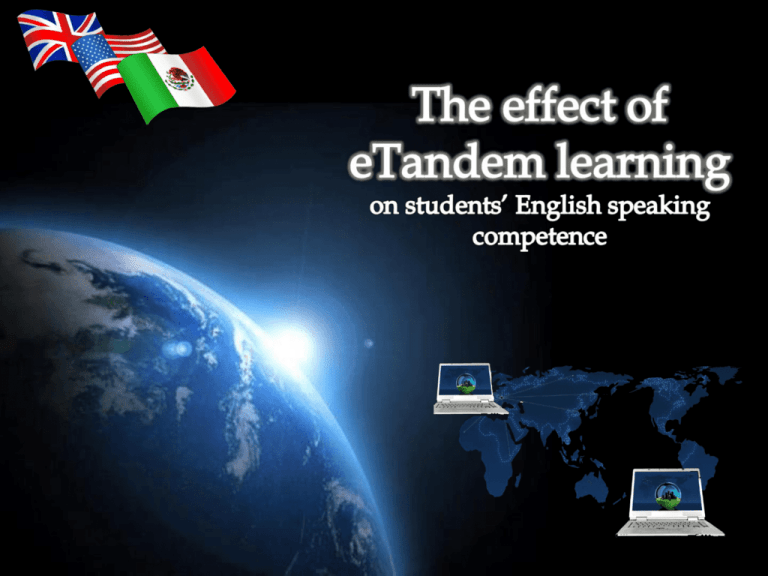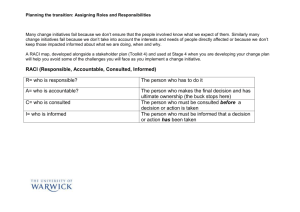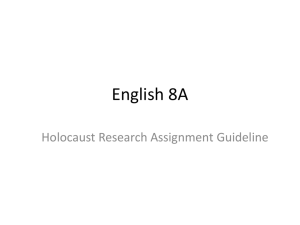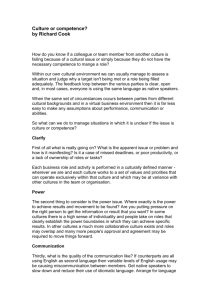
• Many learners throughout the years have enrolled in the B.A. with a low or
no level of English at all.
• Few opportunities to talk to native speakers.
• Wide exposure to inaccurate non-native language models.
• No authentic language practice outside the classroom.
• Tendency for academic and bookish English teaching and learning.
• Lack of language practice in a real English-speaking environment.
• A solution that can help learners develop their speaking
skills.
• A language learning environment where authentic
communication can be promoted through synchronous
interaction.
• A solution that can be financially accessible so that all
students can be benefited.
To investigate the effect that eTandem language learning through
synchronous oral CMC with native speakers has on the improvement of
Mexican students’ English speaking competence; this based on their own
reflections and perceptions of improvement during and after the exchange.
“Competences are the sum of knowledge, skills, and
characteristics that allow a person to perform actions”, (CEFRL,
2001:9).
Communicative competence, according to Canale and Swain (1980),
consists of four different types of competence: grammatical competence,
discourse competence, sociolinguistic competence and strategic
competence.
These four competences are equally important for individuals to
communicate successfully in any situation by adapting themselves to the
social and cultural characteristics of the context and overcoming any
communication problems caused by their use of the language.
(a) From students ’ perception, does eTandem language learning through
synchronous oral CMC activities with English native speakers help them
improve their speaking competence?
(b) What aspects of the eTandem language learning experience do students
believe contributed to the improvement of their speaking competence?
(c) What kinds of knowledge and skills do students believe they gained through
eTandem language learning synchronous verbal exchanges that they had not
gained through F2F speaking classes?
(d) According to learners, what aspects need to be considered to replicate
eTandem language learning studies through synchronous oral CMC with
English native speakers in future semesters in this particular teaching and
learning context?
•
a lack of studies regarding eTandem language learning in
Mexico (most research in the field has involved language
partnerships from countries such as Spain, Germany, the
UK, China, Japan, the United States and Brazil)
•
most research however has focused on the development
of learners ’ writing skills through synchronous and
asynchronous written CMC such as e-mail, electronic
bulletin boards, and text-based chats
• A Task-based Approach to eTandem Learning - free
conversation with clear communicative goals
(Appel et al, 2009; Long, 1989)
• Implementation of Learning Portfolios in eTandem
Language Learning ((Walker, 2003; Truscott and
Morley, 2003; Vinagre and Muñoz, 2011)
• Adaptation of guidelines to direct the exchange
(Calvert, 1992; Lewis, 2005, Vinagre, 2007,
Vinagre, 2011)
• Qualitative research
• Pre and post Interviews
• Students’ portfolios:
- Learning Plan
- Learning Record
- Learning Reflection
• Five seventh-semester students from the B.A. in
English Language Teaching at the University of
Hidalgo
• Five English native speakers, learners of Spanish
from the University of Southampton
• The tasks included an introductory task for
participants to meet each other, two tasks based
on a topic from the Mexican learners’ syllabus, two
free tasks to be negotiated between partners, and
a final task for general feedback
(a)From students ’ perception, does eTandem language
learning through synchronous oral CMC activities with
English native speakers help them improve their speaking
competence?
(b)Pronunciation
(c) Vocabulary
(d)Fluency
(e)Grammar
(f) Confidence
(b) What aspects of the eTandem language learning
experience do students believe contributed to the
improvement of their speaking competence?
Interaction with native speakers
Feedback from language partners
Written support
(c) What kinds of knowledge and skills do students believe
they gained through eTandem language learning
synchronous verbal exchanges that they had not gained
through F2F speaking classes?
Knowledge (vocabulary, informal expressions, cultural
information)
Skills (authentic listening practice, speaking)
Grammatical and discourse competence
(Tian and Wang, 2010)
(d) According to learners, what aspects need to be
considered to replicate eTandem language learning studies
through synchronous oral CMC with English native speakers
in future semesters in this particular teaching and learning
context?
Language tasks
eTandem learning portfolio (space for writing feedback for
their partners)
Organisation for the exchange
Incorporation of carefully designed language tasks to
develop the four types of competence (Canale and Swain,
1980)
Extend the length of the exchange for significant
improvement
Effective language partnerships
• Implementation of Tandem language learning projects with
other schools
• Tandem networks
Active Worlds
http://www.activeworlds.com (consulted 14/02/12)
Appel, C. et al. (2009) ‘Skype-based tandem language learning and Web 2.0’. In Thomas, M. (ed) Handbook of Research
on Web 2.0 and Second Language Learning. Information Science Reference.
Brown, D. (2007a) Teaching by Principles An Interactive Approach to Language Pedagogy. The United States of America:
Pearson Longman.
Brown, D. (2007b) Principles of Language Learning and Teaching. The United States of America: Pearson Longman.
Brown, J. D. & Rodgers, T. (2002) Doing Second Language Research. Oxford: Oxford University Press.
Busuu.com Your Language Learning Community
http://www.busuu.com/ (consulted 04/07/11)
Calvert, M. (1992) ‘Working in tandem: Peddling an old idea’. Language Learning Journal, 6, 17-19
Centre for Languages Linguistics and Area Studies (2010) A review of tandem learning: from face-to-face to social
networking software.
http://www.llas.ac.uk/video/6126 (consulted 13/02/12)
CILT The National Centre for Languages (2007) European Language Portfolio for Adult and Vocational Language Learners.
www.cilt.org.uk/further_and_adult_education/teaching_and_learning/resources/adult_elp.aspx (consulted 10/11/11)
Cohen, L., Manion, L., and Morrison, K. (2007). Research Methods in Education
(6th ed.). London: Routledge/Falmer.
Council of Europe (2001) Common European Framework of Reference for Languages: Learning, teaching, assessment.
http://www.coe.int/t/dg4/linguistic/source/framework_en.pdf (consulted 24/10/11)
Cziko, G. (2004) ‘Electronic tandem language learning (eTandem): A third approach to second language learning for the
21sr century’. CALICO Journal, 22:1, 25-39
Denzin, N. & Lincoln, Y. (2005) ‘Introduction: The discipline and practice of qualitative research’. In Denzin, N. & Lincoln, Y.
(eds) The Sage Handbook of Qualitative Research Third Edition. Sage Publications.
Dooley, M. (2007) ‘Choosing the appropriate communication tools for an online exchange’. In R. O’Dowd (ed) Online
Intercultural Exchange. Multilingual Matters LTD.
Dörnyei, Z. (2007) Research Methods in Applied Linguistics. Oxford: Oxford University Press.
Ellis, R. & Barkhuizen, G. (2005) Analysing Learner Language. Oxford: Oxford University Press.
ePaLs Global Community
http://www.epals.com/ (consulted 01/11/11)
eTandem Europa
http://www.cisi.unito.it/tandem/etandem/etindex-en.html (consulted 10/11/11)
Hauck, M. & Lewis, T. (2007) ‘The tridem project’. In R. O’Dowd (ed) Online Intercultural Exchange. Multilingual Matters
LTD.
Howard, C. (2012) E-Learning Symposium 2012. Using a Social Networking Site to Facilitate Tandem Language and
Culture Learning.
http://www.llas.ac.uk/video/6567 (consulted 13/02/12)
International Tandem Network
http://www.cisi.unito.it/tandem/learning/idxeng11.html (consulted 10/11/11)
İşler, Y. (2005) Learner Autonomy and Language Learning Portfolios: A Study on the Development of Reading and
Vocabulary. Bursa.
http://www.belgeler.com/blg/r6i/learner-autonomy-and-language-learning-portfolios-a-study-on-the-development-of-readingand-vocabulary-ogrenir-otonomisi-ve-dil-ogrenme-portfoyleri-okuma-ve-sozcuk-bilgisi-uzerine-bir-calisma (consulted
10/11/11)
Jianqiu, T. & Yuping, W. (2010) ‘Taking language learning outside the classroom: learners’ perspectives of eTandem
learning via Skype’. Innovation in Language Learning and Teaching, 4:3, 181-197
Kabata, K. & Edasawa, Y. (2011) ‘Tandem language learning through a cross-cultural keypal project’. Language Learning
& Technology, 15:1, 104-121
Kötter, M. (2002) Tandem Learning on the Internet. Germany: Peter Lang Europäischer Verlag der Wissenschaften.
Lamy, M.N. & Hampel, R. (2007) Online Communication in Language Learning and Teaching. Great Britain: Palgrave
Macmillan.
Language Learning with Livemocha
http://www.livemocha.com (consulted 02/03/12)
Lina, L. (2002) ‘Enhancing learner’ communication skills through synchronous electronic interaction and task-based
instruction’. Foreign Lanugage Annals, 35:1, 16-23
Lina, L. (2007a) ‘Fostering second language oral communication through constructivist interaction in desktop
videoconferencin’. Foreign Lanugage Annals, 40:4, 635-649
Lina, L. (2007b) ‘One-to-one desktop videoconferencing for developing oral skills: Prospects in perspective’. In R. O’Dowd
(ed) Online Intercultural Exchange. Multilingual Matters LTD.
Lewis, T. (2005) ‘The effective learning of languages in tandem’. In J. Coleman & J. Kappler (eds) Effective Learning and
Teaching in Modern Languages. Routledge Taylor and Francis Group.
Little, D., & Brammerts, H. (1996) ‘A guide to language learning in tandem via the Internet’. CLCS Occasional Paper No.
46. 1-87
Mackey, A. & Gass, S. M. (2005) Second Language Research: Methodology and Design. Mahwah, NJ: Lawrence Erlbaum.
Nunan, D. (1992). Research Methods in Language Learning. Cambridge: Cambridge
University Press.
Occeña, E. (1998) Assessing Self-Access Learning at the Self-Access Center of the Universidad Autonoma del Estado de
Hidalgo.
O’Rourke, B. (2007) ‘Models of telecollaboration (1): eTandem’. In R. O’Dowd (ed) Online Intercultural Exchange.
Multilingual Matters LTD.
pools-m (2011) eTandem learning. Autonomous language learning with a partner.
http://languages.dk/archive/pools-m/manuals/final/etandemuk.pdf (consulted 03/10/11)
Richards, K. (2003) Qualitative Inquiry in TESOL. Basingstoke: Palgrave Macmillan.
Second Life
http://secondlife.com/ (consulted 13/02/12)
Schneider, C. & Panichi, L. (2009) International Conference ICT for Language Learning 2nd Edition. Second Life as a Virtual
Platform for Language Education.
http://www.pixel-online.net/ICT4LL2009/common/download/Proceedings_pdf/Christel_Schneider,Luisa_Panichi.pdf
(consulted 13/02/12)
Swertz, C. et al. (2010) ‘Towards a methodology of language learning in 3D environments. Evaluation results from the
AVALON language courses in Second Life’. In ITEC 2010.
http://www.kuleuven-kulak.be/itec2010/programme/submissions/itec2010_submission_22.pdf (consulted 13/02/12)
Telles, J. & Vassallo, M. (2006a) ‘Foreign language learning in-tandem: A critical review of its theoretical and practical
principles.’ (unpublished)
http://usp-br.academia.edu/marialuisavassallo/Papers/1186646/Foreign_language_learning_in-tandem (consulted 03/10/11)
Telles, J. & Vassallo, M. (2006b) ‘Foreign language learning in-tandem: Teletandem as an alternative proposal in CALLT’.
The ESPecialist, 27:2, 189-212
Travelers Network
http://travelersnetwork.net/ (consulted 14/02/12)
Truscott, S. & Morley, J. (2003) ‘Case study 11 language learning in tandem’. LTSN Genetic Centre, 149-160
University of Southampton School of Humanities (2001/2002) Overview of the Southampton language stages.
http://www.soton.ac.uk/cls/courses/overviewofstages.pdf (consulted 14/02/12)
Vinagre, M. (2007) ‘Integrating tandem learning in higher education’. In R. O’Dowd (ed) Online Intercultural Exchange.
Multilingual Matters LTD.
Vinagre, M. & Munoz, B. (2011) ‘Computer-mediated corrective feedback and language accuracy in telecollaborative
exchanges’. Language Learning & Technology, 15:1, 72-103
Woodin, J. (1997) ‘Email tandem learning and the communicative curriculum’. ReCALL, 9:1, 22-33
Martha Guadalupe Hernández Alvarado
martha_her3@hotmail.com




